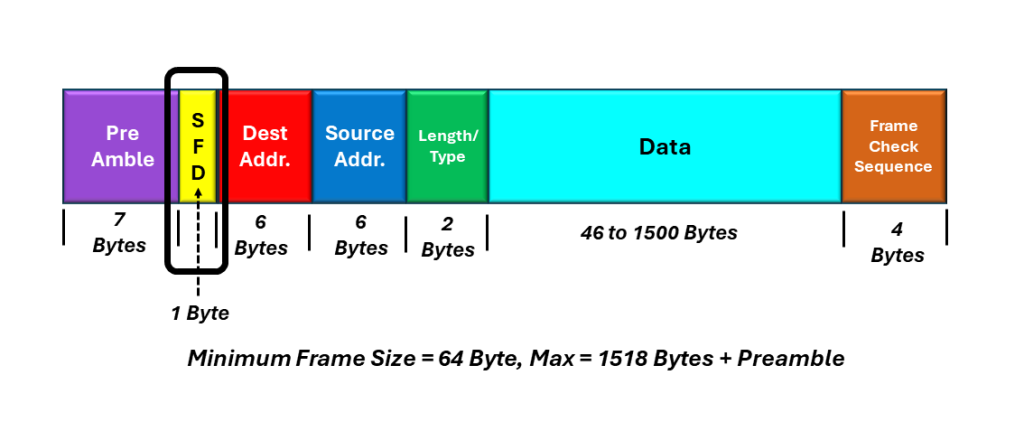in 1985, the Institute of Electrical and Electronic Engineers (IEEE) published their first IEEE 802.3 standard, defining their own version of the Ethernet Frame.
Over time, there were some changes to this Ethernet frame structure, and the current IEEE 802.3 (Basic) Ethernet frame is as shown below in Figure 1.

Figure 1, The IEEE 802.3 (Basic) Frame Structure/Format.
Why the Word “Basic”?
I include the word “Basic” to differentiate this format of the Ethernet frame from other IEEE 802.3 formats, such as:
- IEEE 802.3 Compliant Ethernet frame – with Q-Tag
- IEEE 802.3 Compliant Ethernet frame – with Envelope Prefix and/or Suffix
These other two frames have also been standardized in IEEE 802.3. However, each of these frame formats are different from each other.
Very Similar to the DIX Frame
The IEEE 802.3 (Basic) Ethernet frame is almost identical to the DIX frame.
It can have a minimum frame length of 64 bytes and a maximum frame length of 1518 bytes (not including the Preamble). Hence, the length of this frame is identical to that of the DIX Frame.
Preamble Differences
In reality, the Preamble of the IEEE 802.3 frame is identical to that of the DIX Frame. However, the IEEE Committees have defined the Preamble differently than the DIX Consortium.
I illustrate the Preamble (within the IEEE 802.3 Basic Ethernet frame) in Figure 2.

Figure 2, Illustration of the Preamble (within the IEEE 802.3 Basic Ethernet frame).
The IEEE 802.3 Standard defines the Preamble as a 7-byte field (each byte with the value of 0xAA (or 10101010 – in binary format). This standard also defines the 8th byte (of the Preamble) as a Start of Frame Delimiter (SFD). In this case, the SFD byte always has the value of 0xAB (or 10101011 – in binary format).
I show an illustration of the IEEE 802.3 (Basic) Ethernet frame format, with the SFD byte highlighted below in Figure 3.

Figure 3, Illustration of the IEEE 802.3 (Basic) Ethernet frame format, with the SFD byte highlighted.
Please note that although the DIX and IEEE standards define the Preamble differently, if you look closely at the byte values (of the Preamble), the Preamble for the DIX Frame and the Preamble plus SFD for the IEEE frame are identical.
The Length/Type Field
Another difference between the DIX and the IEEE 802.3 frames is in the “Type” or “Length/Type” field.
I show an illustration of the IEEE 802.3 (Basic) Ethernet frame, with the Length/Type field highlighted in Figure 4.

Figure 4, Illustration of the IEEE 802.3 (Basic) Ethernet frame format, with the “Length/Type” field highlighted.
The first version of the IEEE 802.3 standard (published in 1985) defined this particular field as the “Length” field. However, in 1997, the IEEE 802.3 Committee changed this field to the “Length/Type” field, to be compatible with the DIX Standard.
How Does the Length/Type Field Work?
The current standards define the Length/Type field as follows:
If the Length/Type field value is 1500 (or 0x05DC in Hexadecimal)
If the Length/Type field is 1500 (or 0x5DC in hexadecimal), then this 16-bit field will function as the “Length” field. The value of the “Length/Type” field will then reflect the number of octets, within the Data field of the Ethernet frame.
If the Length/Type field value is greater than 1536 (or 0x0600 in Hexadecimal) – Compatible with DIX Frame
If the Length/Type field is greater than 1536 (0x0600 in hexadecimal), then this 16-bit field will function as a “Type” field. In this case, the value of the “Length/Type” field indicates the type of protocol data, that the Ethernet frame is transporting (just like for DIX frames).
In another blog post, I present a list of standard values for the Length/Type field (when the value is greater than 1536), along with their meaning.

